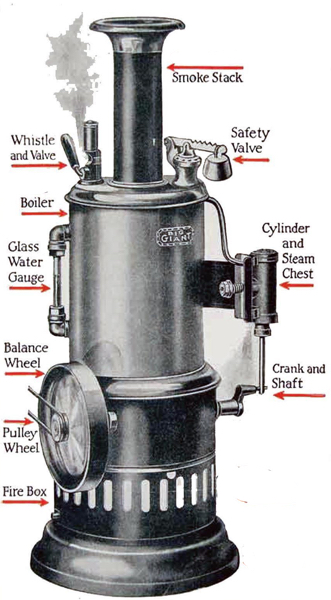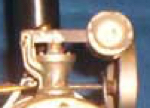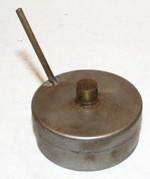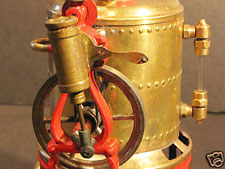"Steam 101"
|
How a Toy Steam Engine
Works
Safety Valves You will find four basic styles of
safety valves, FIgure 1 is the most common, it has a
spring loaded plunger and threads into the boiler.
Figure 2 is an older style of the spring loaded
plunger, you unscrew the top to fill the boiler. Make
sure the plunger is free to move and there is spring
pressure with these two styles. Figures 3 and 4 are
weighted styles, the arm with the weight attached puts
pressure on a plug to block steam from escaping, lift
the arm up to fill boiler.
Burners If unit is flame heated fill burner
about half full with Wood alcohol, which is also known
as Methanol, Methyl Hydrate or Methylated Spirits.
Adjust wick height so tip of the flame just touches
bottom of boiler. Keep an eye on the water level in
the boiler, do not let it run dry. After a few runs
you will have a good idea how much alcohol to add to
the burner to get a maximum run time. Figure 5 is
common for most upright models, however larger units
may use double wick burners similar to figure 6.
Figure 7 is typical of most horizontal boiler models.
Alcohol vapors can communicate flame,
so fire doesn't have to touch the liquid, it can
ignite the vapor that comes from evaporating alcohol.
Always be sure the flame is extinguished before
refilling the burner, be aware that outside in
daylight it is often difficult to see the burning
flame.
With an electrically heated boiler it
is simply a matter of plugging it in and waiting for
the boiler to come up to pressure. With an
electrically heated boiler there is a greater risk of
boiling the boiler dry, it is very important to keep
an eye on the water level.
A note of caution, the
original electrical cords had two prongs with no
ground, for safer operation they can be changed to a
three prong configuration. Instructions here.
Boilers
|








 Figure 7
Figure 7